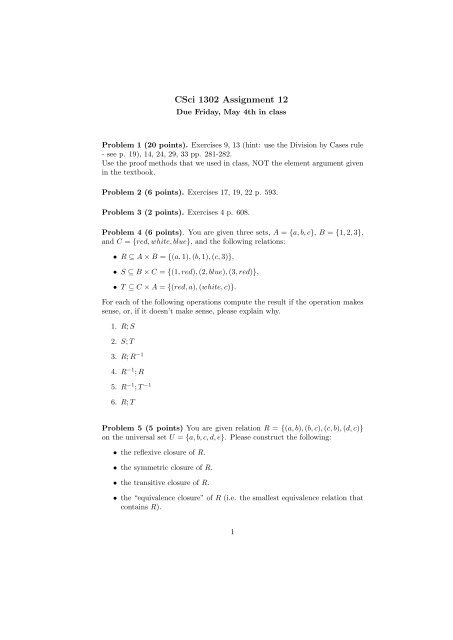Problem set 12 - Facultypages.morris.umn.edu
Problem set 12 - Facultypages.morris.umn.edu Problem set 12 - Facultypages.morris.umn.edu
CSci 1302 Assignment 12 Due Friday, May 4th in class Problem 1 (20 points). Exercises 9, 13 (hint: use the Division by Cases rule - see p. 19), 14, 24, 29, 33 pp. 281-282. Use the proof methods that we used in class, NOT the element argument given in the textbook. Problem 2 (6 points). Exercises 17, 19, 22 p. 593. Problem 3 (2 points). Exercises 4 p. 608. Problem 4 (6 points). You are given three sets, A = {a, b, c}, B = {1, 2, 3}, and C = {red, white, blue}, and the following relations: • R ⊆ A × B = {(a, 1), (b, 1), (c, 3)}, • S ⊆ B × C = {(1, red), (2, blue), (3, red)}, • T ⊆ C × A = {(red, a), (white, c)}. For each of the following operations compute the result if the operation makes sense, or, if it doesn’t make sense, please explain why. 1. R; S 2. S; T 3. R; R −1 4. R −1 ; R 5. R −1 ; T −1 6. R; T Problem 5 (5 points) You are given relation R = {(a, b), (b, c), (c, b), (d, c)} on the universal set U = {a, b, c, d, e}. Please construct the following: • the reflexive closure of R. • the symmetric closure of R. • the transitive closure of R. • the “equivalence closure” of R (i.e. the smallest equivalence relation that contains R). 1
CSci 1302 Assignment <strong>12</strong><br />
Due Friday, May 4th in class<br />
<strong>Problem</strong> 1 (20 points). Exercises 9, 13 (hint: use the Division by Cases rule<br />
- see p. 19), 14, 24, 29, 33 pp. 281-282.<br />
Use the proof methods that we used in class, NOT the element argument given<br />
in the textbook.<br />
<strong>Problem</strong> 2 (6 points). Exercises 17, 19, 22 p. 593.<br />
<strong>Problem</strong> 3 (2 points). Exercises 4 p. 608.<br />
<strong>Problem</strong> 4 (6 points). You are given three <strong>set</strong>s, A = {a, b, c}, B = {1, 2, 3},<br />
and C = {red, white, blue}, and the following relations:<br />
• R ⊆ A × B = {(a, 1), (b, 1), (c, 3)},<br />
• S ⊆ B × C = {(1, red), (2, blue), (3, red)},<br />
• T ⊆ C × A = {(red, a), (white, c)}.<br />
For each of the following operations compute the result if the operation makes<br />
sense, or, if it doesn’t make sense, please explain why.<br />
1. R; S<br />
2. S; T<br />
3. R; R −1<br />
4. R −1 ; R<br />
5. R −1 ; T −1<br />
6. R; T<br />
<strong>Problem</strong> 5 (5 points) You are given relation R = {(a, b), (b, c), (c, b), (d, c)}<br />
on the universal <strong>set</strong> U = {a, b, c, d, e}. Please construct the following:<br />
• the reflexive closure of R.<br />
• the symmetric closure of R.<br />
• the transitive closure of R.<br />
• the “equivalence closure” of R (i.e. the smallest equivalence relation that<br />
contains R).<br />
1
You may list pairs included in the resulting relations or draw the relations, each<br />
as a separate diagram.<br />
That’s all, folks!<br />
2



